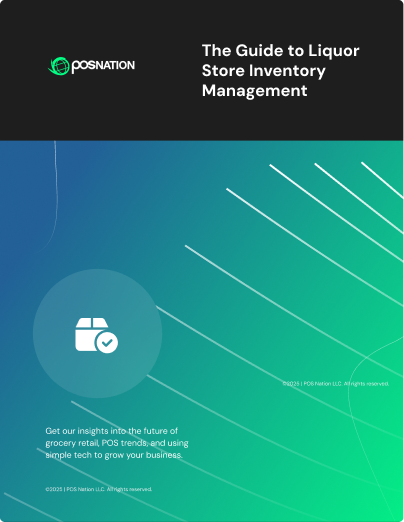If you're running a small grocery store, you're feeling the pressure from all sides.
Customer expectations are higher, inflation is causing challenges for store owners and customers alike, and the big-box chains seem to have endless resources to throw at the latest trends.
It's enough to make you wonder if your neighborhood store can keep up.
You can absolutely compete in the modern market. Independent small grocery stores are actually better positioned than the chains to capitalize on some of the top trends sweeping the industry in 2025 and beyond.
But what are those key trends? And how can get get the most out of them for your business?
This guide covers seven grocery store trends that don't require massive budgets or corporate-level resources to leverage.
Understanding Today's Grocery Store Trends Landscape
The grocery industry is in the middle of a major shift.
We saw average unit prices jump 4-8% in 2023, then some further price increases by an average of an additional 1.7% in 2024. Though inflation seems to be slowing down, customers are still feeling the pinch.
Shoppers are adjusting their habits, hunting for deals, switching to generic brand products, and being more strategic about where they shop. Customers are also more likely than ever to shop both online and in-store for their grocery products.
Related Read: How To Operate a Grocery Store: 6 Tools for Success
The good news for independent grocery store owners is that these changes create some serious opportunities for businesses in your category… if you know how to capitalize on them.
While big chains are struggling to adjust their oversized supply chains, stores like yours can leverage community connections, a personal touch, and the agility that comes with being a smaller business to give customers what they want.
The key is understanding which trends matter most and how to implement them without breaking your budget. Let's examine seven game-changing trends that can help your store thrive in 2025.
1. Smart Inventory Management Tools
It’s estimated that 30% of the world’s food supply goes to waste. Some of this waste happens once your products hit your customers’ refrigerators, but plenty of spoilage happens right on grocery store shelves.
Small stores tend to get hit hardest by increases in losses due to spoilage. Big chains can often absorb losses without too much trouble, but they hit small businesses right where it hurts: the bottom line.
When you implement the right inventory management processes and tools, you can minimize these losses without a massive upfront investment.
Modern point of sale (POS) systems come with built-in intelligence that tracks your sales patterns and automatically suggests reorders based on what's actually moving off your shelves.
The right point of sale system for an independent grocery store can set automated reorder alerts, track your stock in real time, and help you analyze sales patterns and monitor expiration dates with advanced reporting.
2. Hyper-Local and Community-Focused Strategies
American shoppers spent an estimated $3.81 trillion at local stores in 2023, a number that has been on the rise over the past few years and is only expected to increase in the coming years.
Modern customers want to shop local when they can: they’re craving a personal touch, and your independent grocery store is well-positioned to give it to them.
The advantage of running a smaller store is that it makes it easier to pivot instead of having to do one-size-fits-all approaches.
- Partner with local producers to offer fresh, unique products you can't find elsewhere.
- Create dedicated "shop local" sections that tell the story behind your products.
- Host community events like farmers market days or local vendor showcases.
These strategies don't require huge marketing budgets, just some planning and community engagement. When you knit your store into the fabric of your community, you’ll have an easier time winning regular, loyal customers.
3. Value-Driven Shopping and Strategic Pricing
With inflation on the rise, it’s no surprise that more consumers are turning to generic and private label products. This trend might seem like terrible news to independent grocers, but with the right strategy, you can still turn this into an opportunity.
Related Read: The Guide to Grocery Store Profit Margins (and How To Improve Them)
You can't compete on price alone with the big chains, but you don't need to. Instead of joining their race to the bottom with pricing, position yourself based on value.
- Use dynamic pricing through your POS system to respond quickly to market changes.
- Create targeted promotions based on customer purchase history and preferences.
- Highlight quality and unique offerings that justify premium pricing.
- Develop "value zones" featuring competitively priced essentials without sacrificing margins.
Remember, value isn't just about the lowest price. It's about the total shopping experience. Customers will pay more for great service or incredible convenience… You just have to show them you can offer them those advantages.
4. Faster Checkout and Operational Efficiency
Today’s customers are less patient than ever before. They want things to be quick and efficient. They’re also more likely than ever to seek out fast checkout options like self-checkout. Almost three-quarters of modern consumers prefer self-checkout to standing in line for a clerk.
If you’re saying, “But wait, I thought great service and my personal connection were my biggest competitive advantages,” hang tight.
Related Read: Speeding Up Your Grocery Store Checkout Line: 6 Tips for Efficiency
The key is not to fully automate your store and replace your staff with robots, it’s to find the right balance between modern tech and human connection. In other words, you don’t need to cut out your hardworking staff; just give them some better tools:
- Integrate mobile payment options like Apple Pay, Google Pay, and contactless cards for faster transactions.
- Implement POS systems like Markt POS that are designed for grocery stores and can handle inventory, loyalty programs, and reporting in one platform.
- Offer hybrid checkout options where customers can choose self-service or personal assistance.
- Simplify back office operations with automated reporting and inventory management.
The goal is to implement whatever tools and technology make sense to help free up your staff to focus on providing the kind of personalized service that keeps customers loyal.
5. Health, Wellness, and Specialty Products
The wellness market is on the rise, and 82% of consumers now consider wellness to be a top priority in life. These customers are willing to pay a premium for sustainable products designed to boost long-term health.
Your small store advantage shines in this trend. Big chains have limited shelf space for specialty items, but you have the freedom to create curated sections that feature the wellness products your community wants to see.
When customers see you as the go-to spot for all their favorite wellness products, you build stronger relationships and higher-margin sales.
6. Prepared Foods and Grab-and-Go Convenience
Modern shoppers are busy. They want more than just ingredients to use to cook their own food: they want easy, grab-and-go options they can pick up on the way home from work or after a long week.
Getting into the prepared foods market is a strong strategy for grocers today. The good news is you don’t need a full commercial kitchen to get started. You can start small:
- Partner with local bakeries or delis to offer fresh sandwiches, salads, and prepared meals.
- Focus on high-turnover items like coffee, breakfast pastries, or simple lunch options.
- Consider beverage options, as specialty drinks like fancy coffee items often have great margins and bring in repeat customers.
The key is starting simple and scaling up. Test the waters with a few popular items, track what moves, and gradually expand your offerings. Be sure to research all health department requirements before investing in any food prep equipment or starting to offer prepared foods in your store.
Related Read: What Is a Food Handling License? [And How To Get One]
7. Increased Customer Loyalty
The average shopper today belongs to over 15 loyalty programs. That might sound overwhelming (and overcrowded), but it’s actually great news: it means customers are open to loyalty programs, as long as they provide real value.
Implement a loyalty program in your store to take advantage of this trend and bring more repeat business into your grocery store. Start by implementing a modern POS system like Markt POS with built-in customer loyalty features. Then, consider some of these steps:
- Send personalized offers based on actual shopping history pulled from your sales data and customer relationship management tool.
- Use email marketing to share store news, special events, and exclusive deals.
- Integrate social media to showcase new products or local partnerships.
Remember, the goal of your loyalty program is to connect with your best customers, offer them additional value, and encourage them to become advocates of your business for years and years.
Implementing These Grocery Store Trends
The seven trends listed in this post all offer opportunities you can use to build a competitive advantage for your independent grocery store.
But if you’re feeling overwhelmed looking at all these stats and unsure how to get the best result for your store, you’re not alone. The good news is, you don’t have to try to implement everything at once.
The key is starting small and scaling gradually. Step one? Investing in the right tool to help you manage all your new processes and strategies. A modern grocery POS system is the centerpiece of all your operations, from inventory management to customer loyalty to checkout processes for your store.
We recommend an all-in-one solution, like Markt POS, that handles variable weight tracking, automated reordering, customer loyalty programs, and provides real-time reporting. It’s designed specifically for independent grocers who want to compete with the big chains without the big budgets.
Ready to see how these trends can transform your store? Schedule a free demo of Markt POS today.







 by Brian Sullivan
by Brian Sullivan

 by Cort Ouzts
by Cort Ouzts
